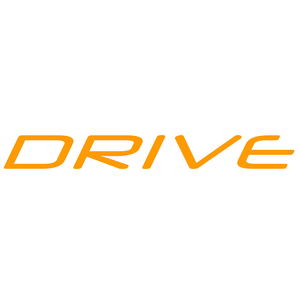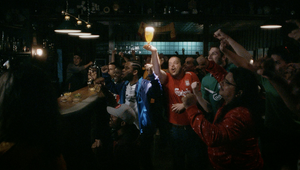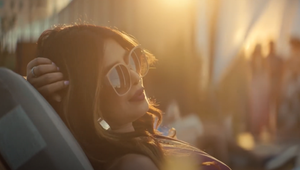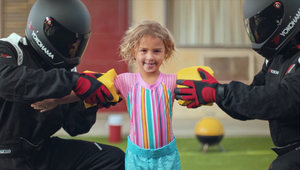
Conjuring Fire and Rain for Billie Eilish x Adobe

Adobe believes that creativity belongs to everyone and everyone’s story deserves to be told, from the world’s biggest stars to students just starting out. For ‘Create What’s True To You’, the brand called upon one of the biggest creative influencers of the modern day: American singer-songwriter Billie Eilish.
As an inspiration to the next generation of creators, Billie joins Adobe for a spot ‘Create What’s True To You’ as well as a mini documentary to give viewers a peek into her creative ideation process for her single release, ‘Happier Than Ever’ - a self-directed music video created using Adobe Creative Cloud.
To find out how it all came together, LBB joins Drive Studios director Rich Lee, who reveals what it was like to work with the star on his dream collaboration.
LBB> What was the brief from the client and what was your initial reaction?
Rich Lee> Adobe wanted to do a case study in the form of a short documentary and commercial showcasing Billie Eilish’s creative process when approaching her music videos. I loved working with Billie on ‘All the Good Girls Go To Hell’, and think she is one of the most talented and interesting artists working today. I also live and breathe Adobe in my own creative process, so it was a bit of a dream collaboration.
LBB> Tell us about the concept and ideation process - was it straightforward or was there a lot of back and forth?
Rich> The initial brief I got from Billie’s team at Universal was that they wanted to do something about her creative process in the context of an upcoming music video. I also got a nugget of information from the agency - they were imagining Billie walking through a white void, where screens and things would pop up while she spoke about her creative process, so you would see images from her music videos conjured up in the void.
I took those bits of information and ran with them. I wanted to really think about how to visualise a creative process both from my knowledge of having worked with Billie before, but also based on how I come up with ideas myself. So I kind of riffed on that, and it just so happens that Billie has a similar process, which is really about spitballing things and trying to find a vibe, shooting darts at an idea until something feels right and then running with it.
So I came up with this idea - what if it is a series of ‘what ifs’? What if it’s almost as though we’re in Billie’s mind and there’s this matrix-style construct she wanders around with ideas coming to life around her? It’s really Billie riffing with herself, where her ideas materialise around her until she finds the right one. It’s a little bit like Goldilocks - this one’s too hot, this one’s too cold, but ultimately this one’s just right.
I purposely kept the written part sparse - I really wanted the images to speak for themselves, so we ended up creating a few dozen bespoke images using CG and illustrations to pinpoint what these scenes would be, and I just wrote it like a little picture book, showing Billie asking all the what ifs. I tried to make an image per moment so that as everyone read the treatment, they could actually see it right before their eyes. It was almost like storyboards and illustrations turned into a pitch deck. Billie and her team loved it and sent it off to the agency, who also loved it. It’s actually one of my favorite treatments ever, because it really read like a story, and it felt like that resonated.
Initially I imagined that at the very end of the commercial, after traveling through this void and seeing all these amazing things happening around Billie, we would pull out of the void past her computer screen and into the real world where we would see all the different Adobe programs on her screen that she was using for her creative process. There was Photoshop open with a bunch of reference images, After Effects with a RAM preview of a bunch of visual effects, and Premiere open with a music video edit. But as it turned out, Adobe preferred keeping the spot in the void and only incorporating hints of the UI throughout. That was really the main note on the treatment. Other than that it was just a few tweaks here and there.
LBB> What was it like collaborating with Billie Eilish on this?
Rich> It was easy. When she’s behind something, she’s behind it, and she’ll tell you if she’s not. But the stars really aligned on this one and she was excited about the concept and all the different ideas. She was great. In pre-production there wasn’t a lot of back and forth, because she was on board with the concept and we did a lot of work to make sure all parties were up to speed on what we were up to.
On set, we had to shoot everything in one really long day which can be tiresome for a lot of artists and celebs, but she hung out. She had a great Spotify playlist going, her dog Shark showed up along with her Mum and Dad. It was pretty chill.
One thing that was interesting was that we were shooting these interviews for the behind the scenes documentary at the same time, and I don’t usually get involved in the BTS, but in this case the agency asked if I would do the interviews because we were asking very specific questions about the creative process. It was really fun to grill Billie and to hear her responses which were often not what you would expect because she is such a unique person.
That part was really fun, and I ended up going on set for her music video to shoot more BTS. I really didn’t want the interviews to be staged. I wanted to have the interviews and BTS be more organic. Since she was directing and starring in her own video, there was an opportunity to talk to her in situation, and in the moment, whether she was about to open a door to a flood, jump into water, swim around between takes, or stand in the rain. I wanted it to feel more casual, and therefore more authentic, and thankfully, she was open to that. So whenever I found a moment on set I would throw a question out to her and see how she responded. It was pretty fun. I also hung out when she was cutting the video, so I could chat with her right in the middle of her process.
LBB> What were your favourite moments from this project?
Rich> I think with the commercial we didn’t do anything all that elaborate on set because we were shooting on a blacked out cyc, and other than the rain, everything was imaginary until we generated it in post. Billie’s always fun to be around and yap with between takes, but from a shooting standpoint it wasn’t all that exciting to be honest. That may sound a bit jaded...but let me be super clear I LOVE SHOOTING!
The BTS work was really the most exciting for me. Usually when I’m directing a music video, I’m running around trying to set up shots and the artist comes out of their trailer to film a few takes and then disappears again. In this case, Billie was directing herself, and while she hasn’t directed a lot yet, she has directed most of her most recent work, and she’s learning and experimenting, taking risks, and getting more comfortable in that role.
It was so fun to see this really young person who is obviously wise beyond her years, doing this thing she hasn’t done for all that long, and being really excited about it, wanting to try new things, having a really supportive crew, and then getting in there to do the work. It was a very cool and unique experience for me, and I honestly don’t know if I’ll get to do something like that again.
LBB> What were some of the challenges of this project and how did you overcome them?
Rich> I think the most challenging part of this project was having to shoot it all in one day and also do a bunch of interview work with Billie at the same time, so really it was more of strategic and logistical challenge than anything else. The solution for that was being on point with what the creative was - we had detailed storyboards, and I knew pretty specifically what we needed to do going into the day. We had a pre-light day and my DP, production designer, special effects team, VFX supe, producer and I spent a bunch of time blocking out all the shots and scenes because we had such a short time to do it in.
It was so important that everyone knew what we would be doing from one moment to the next, and we really tried to schedule everything in the smartest way possible so we didn’t have to lose anything. There was a moment in the middle of the shoot day where it seemed like we were going to have to lose a scene or two, but I rolled the dice a bit and convinced everyone that we would catch up… thankfully we did!
When you have a really good, experienced crew full of talented people, projects like this can go really smoothly. Thankfully, the client, agency and Billie were super on board, so there weren’t really any creative hiccups that could have thrown us off course.
LBB> And what were some of the technical and creative decisions made on the directing side?
Rich> A lot of people on the team were adamant that we shoot against a green screen whereas I felt strongly that we should shoot on a blacked out cyc. My argument was that this whole spot takes place in a black void, and while there would be times when we would be making environments behind Billie, everything was predominantly dark.
Having done a lot of visual effects work, I know that when you have a big green screen behind someone, and it’s lit because it has to be in order to pull a good key, then the talent is lit, and there’s all this light bouncing around, and the ambient light on their body is so lifted that they do not settle into a dark frame. It always just ends up looking fake. I didn’t want to have to deal with that. I would rather have the VFX team do more roto here and there to incorporate Billie into an environment. So I made the executive decision to shoot against a black environment.
On top of that, we tried to use the black that was photographed as much as possible in the final. It totally worked, and also saved us a lot of unnecessary post-work since not every single shot needed a full CG background. I think that decision helped the final product a lot.
LBB> What was your reaction to the finished piece? Did it turn out how you envisioned?
Rich> I was happy with the finished piece. The only hiccup was some difference of opinion around one of the scenes which involved an explosion. There were some people who felt the explosion was a little too violent because it was too realistic. We ended up changing it into an anime-type explosion, but even that felt too realistic, so the anime explosion was turned into a sort of gray/beige explosion, which I thought was pretty weird.
In any case, I got to do a director’s cut where the anime explosion had the colours I wanted - closer to the explosion I had originally pitched and envisioned. Other than that, we executed everything we had talked about.
LBB> What is your favourite scene and why?
Rich> There’s a little nod to a video I did for Billie before the pandemic called ‘All the Good Girls Go to Hell’. In the commercial she says, “What if there’s fire?” and all this fire erupts around her, and she scoops some up in her hand. Then she says, “nope, did that already,” and extinguishes it.
The other moment I really like is when Billie is looking in the mirror, and her reflection notices something over her shoulder that catches her attention, causing her to look back to see thunderclouds roaring over her. It’s this playful moment where she’s in a literal brainstorm, and I really love that moment.
LBB> Any other interesting production insight you would like to add?
Rich> I’m a big Billie Eilish fan. She’s incredible and insanely talented. I’m also a really big fan of Adobe and everything they make to help creators do their thing. So much so that my production company and post-house is pretty much entirely Adobe-based.
We cut almost all our projects, from commercials and music videos to features in Premiere. In fact, a feature that I was working on at the same time as the commercial was completely cut in Premiere. We try to composite 80-90% of our work in After Effects, Photoshop is a given, we use Lightroom, and then some.
The fact that we were doing a commercial for Adobe and using their products to actually execute a lot of the work was really fun, and I thought our team at Drive did a fantastic job on all the visual effects and finishing work.











